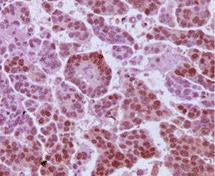High-grade serous carcinoma
(Redirected from High grade serous carcinoma)
High-grade serous carcinoma (HGSC) is a type of epithelial ovarian cancer that is characterized by its aggressive nature and poor prognosis. It is the most common and lethal form of ovarian cancer, accounting for approximately 70% of all ovarian cancer cases. HGSC primarily affects the ovaries, but it can also originate in the fallopian tubes and the peritoneum.
Pathophysiology[edit | edit source]
HGSC is believed to originate from the epithelial cells lining the fallopian tubes, specifically from the fimbriae at the distal end of the tubes. These cells undergo genetic mutations, most notably in the TP53 gene, which is mutated in nearly all cases of HGSC. Other common genetic alterations include mutations in the BRCA1 and BRCA2 genes, which are also associated with an increased risk of breast cancer.
Clinical Presentation[edit | edit source]
Patients with HGSC often present with non-specific symptoms, which can include abdominal pain, bloating, and changes in bowel habits. Due to the vague nature of these symptoms, HGSC is frequently diagnosed at an advanced stage, when the cancer has already spread to other parts of the abdomen and pelvis.
Diagnosis[edit | edit source]
The diagnosis of HGSC typically involves a combination of pelvic examination, imaging studies such as ultrasound, CT scan, or MRI, and blood tests including the measurement of CA-125 levels. Definitive diagnosis is made through histopathological examination of tissue obtained via biopsy or during surgery.
Treatment[edit | edit source]
The primary treatment for HGSC involves a combination of surgery and chemotherapy. Surgical intervention aims to remove as much of the tumor as possible, a procedure known as cytoreductive surgery or debulking. This is usually followed by chemotherapy with platinum-based drugs such as cisplatin or carboplatin, often in combination with paclitaxel.
Prognosis[edit | edit source]
The prognosis for patients with HGSC is generally poor, with a five-year survival rate of less than 50%. The high recurrence rate and the development of chemoresistance contribute to the challenging nature of treating this disease. Ongoing research is focused on identifying new therapeutic targets and improving early detection methods.
Research and Future Directions[edit | edit source]
Current research in HGSC is exploring the role of PARP inhibitors in patients with BRCA mutations, as well as the potential of immunotherapy and targeted therapy to improve outcomes. Efforts are also being made to develop better screening tools to detect HGSC at an earlier, more treatable stage.
See Also[edit | edit source]
References[edit | edit source]
External Links[edit | edit source]
Search WikiMD
Ad.Tired of being Overweight? Try W8MD's physician weight loss program.
Semaglutide (Ozempic / Wegovy and Tirzepatide (Mounjaro / Zepbound) available.
Advertise on WikiMD
|
WikiMD's Wellness Encyclopedia |
| Let Food Be Thy Medicine Medicine Thy Food - Hippocrates |
Translate this page: - East Asian
中文,
日本,
한국어,
South Asian
हिन्दी,
தமிழ்,
తెలుగు,
Urdu,
ಕನ್ನಡ,
Southeast Asian
Indonesian,
Vietnamese,
Thai,
မြန်မာဘာသာ,
বাংলা
European
español,
Deutsch,
français,
Greek,
português do Brasil,
polski,
română,
русский,
Nederlands,
norsk,
svenska,
suomi,
Italian
Middle Eastern & African
عربى,
Turkish,
Persian,
Hebrew,
Afrikaans,
isiZulu,
Kiswahili,
Other
Bulgarian,
Hungarian,
Czech,
Swedish,
മലയാളം,
मराठी,
ਪੰਜਾਬੀ,
ગુજરાતી,
Portuguese,
Ukrainian
Medical Disclaimer: WikiMD is not a substitute for professional medical advice. The information on WikiMD is provided as an information resource only, may be incorrect, outdated or misleading, and is not to be used or relied on for any diagnostic or treatment purposes. Please consult your health care provider before making any healthcare decisions or for guidance about a specific medical condition. WikiMD expressly disclaims responsibility, and shall have no liability, for any damages, loss, injury, or liability whatsoever suffered as a result of your reliance on the information contained in this site. By visiting this site you agree to the foregoing terms and conditions, which may from time to time be changed or supplemented by WikiMD. If you do not agree to the foregoing terms and conditions, you should not enter or use this site. See full disclaimer.
Credits:Most images are courtesy of Wikimedia commons, and templates Wikipedia, licensed under CC BY SA or similar.
Contributors: Prab R. Tumpati, MD


